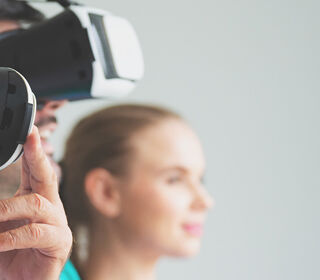
Blog Article

BCU researcher Dr Andrew Wilson has worked with NHS trusts to develop a virtual reality app which allows medical students to learn complex opthalmology diagnosis.
Researcher
Research background
In 2019, a published report on a national survey of eye management in 210 UK Accident and Emergency departments found that there had been a significant reduction in the prevalence of training in the management of eye emergencies since 2013 (77.4% in 2003 compared to 45.5% in 2018). It also found that junior doctors’ confidence in dealing with such diagnoses fell from 36.1% in 2003 to 6% in 2018. At present, ophthalmology teaching at UK medical schools emphasizes practice on real patients; however, obstacles arise due to time constraints in busy clinics and concerns relating to patient discomfort when medical students are starting to learn how to perform this clinical procedure. Therefore, it is extremely important to find alternative cost-effective approaches to train our new doctors. The research was conducted in collaboration with Professor David Carruthers Medical Director at Sandwell and West Birmingham Hospitals NHS Trust.
Have you used our app?
Please take a few minutes to give us your feedback and help us assess how it has benefitted your practice.
Research aims
The aim of the research was to investigate:
- After using the VR simulator were the medical students more confident on being able to perform this procedure on patients in future?
- Did the medical students understand how to perform the correct systematic procedure for performing examinations on the back of the eye?
- Did they learn more about the eye and its pathologies?
- Did they enjoy using the app
Research methods
Medical students were surveyed for their views on the app, its usefulness, easy of use and intent to use it.
Outcomes and impact
Ophthalmology is an important diagnostic skill whose use in clinical practice has been declining since 2013. Junior doctors’ now feel far less confident in their ability to perform this procedure on patients. The work reported in this section was specifically undertaken in collaboration with the NHS to enhance teaching of the correct process doctors need for eye examinations.
Professor Carruthers (Medical Director for Sandwell and West Birmingham Hospitals NHS Trust) states the following about traditional teaching of this skill and its challenges:
“This modality emphasizes practice on real patients; however, obstacles arise due to time constraints in busy clinics and concerns relating to patient discomfort when medical students are starting to learn how to perform this clinical procedure. Therefore, it is extremely important to find alternative cost-effective approaches to train our new doctors.”
During his time as director of medical education it was Professor Carruthers policy for all his students to use this simulation during their induction onto their ophthalmology module. It was also available for self-study and for use in specific skills training for junior doctors in use of an ophthalmoscope. The students can reuse the simulation in their own time when they want without having clinical teaching staff on hand to teach them. This simulation reduces the teaching time needed (2 hours to 10 minutes) whilst still covering all the essential diagnostics skills and correct procedures encapsulated in an enjoyable and interactive way. The simulation can be reused outside of schedule teaching times reducing the cost to teach this important clinical skill. The hospital has an annual intake of approximately 150 students to whom this training is applicable.
The simulation has been formally evaluated by NHS doctors during their teaching of ophthalmology to third- and fourth-year medical students (n=25). They found that 90 percent of their students had no prior experience of virtual reality. After using the simulation more than 80 percent of the students felt it had improved their understanding of the correct processes, their ability to identify the main landmarks in the eye and recognise abnormalities. Most importantly it gave them more confidence to perform the task on a patient in future. After using the simulator the medical students ability to describe the basic anatomy of the eye, recognise key pathologies and their clinical relevance improved by twenty-five percent over their existing knowledge.
Dr Rao who was undertaking the evaluations in 2020 said: “Dr Wilson’s research into the application of a novel virtual reality ophthalmology training simulation has clearly benefitted our undergraduate students in learning this important but challenging diagnostic procedure. At this point in time we are not able to gauge the direct effect on patient care as these students will not be actively practicing medicine for several years. However, we have significantly improved their confidence in their ability to perform this task on patients in future where previously we have found this quite challenging.”
Seventy percent of the medical students asked said they felt these types of simulator would help them learn new clinical skills in the future. Eighty percent felt that it was a good use of medical schools’ budget.